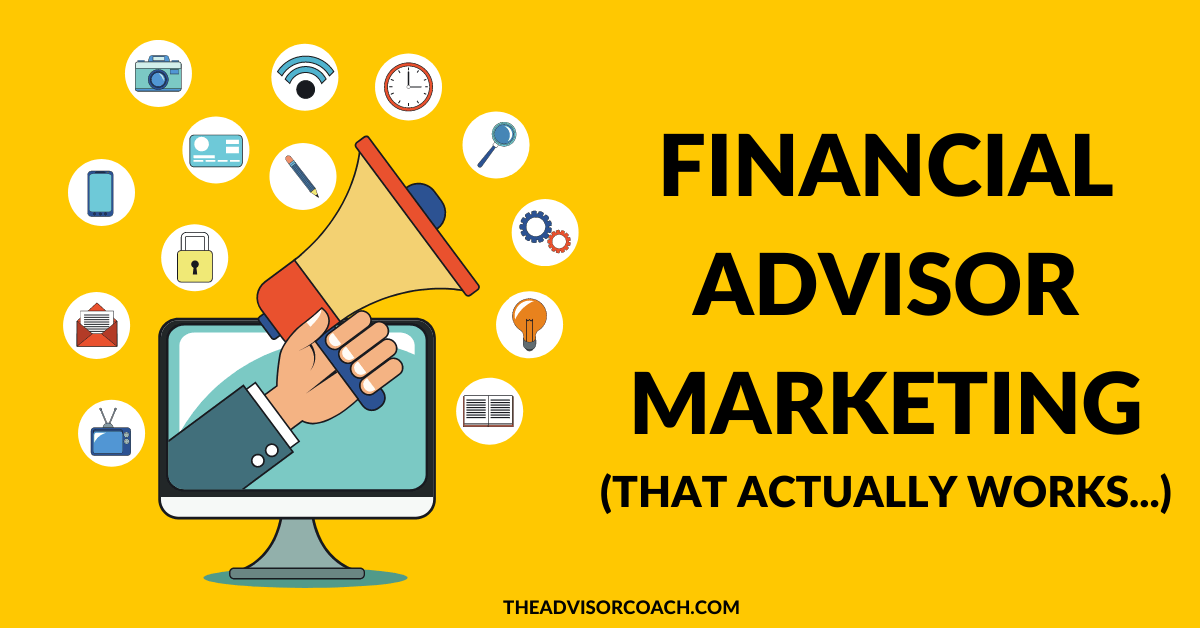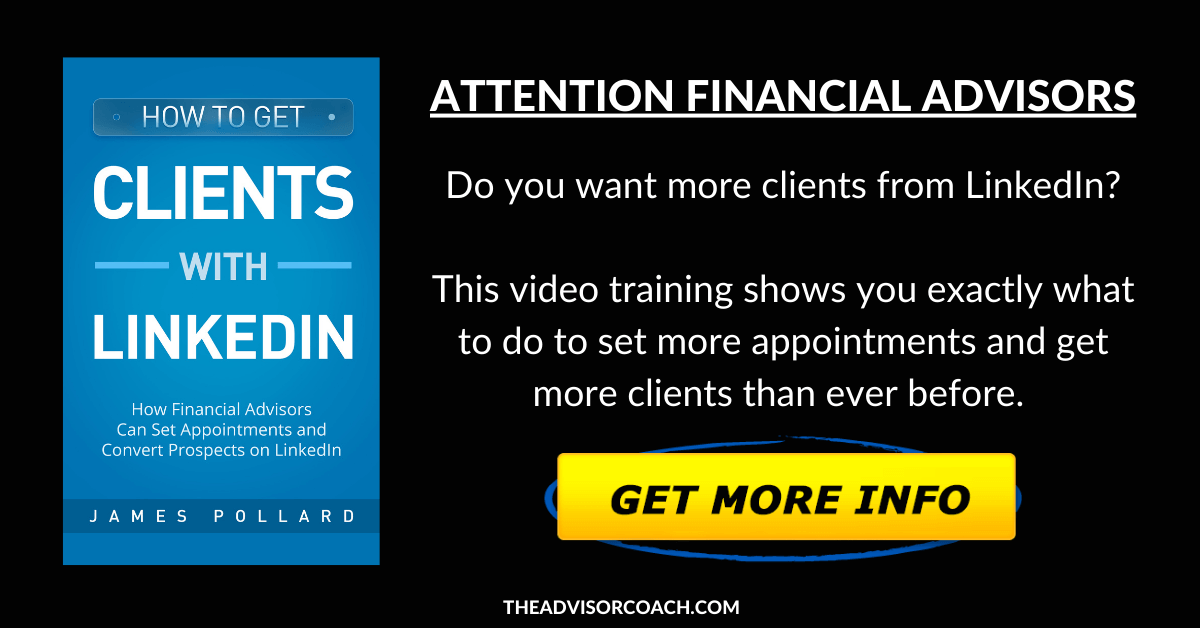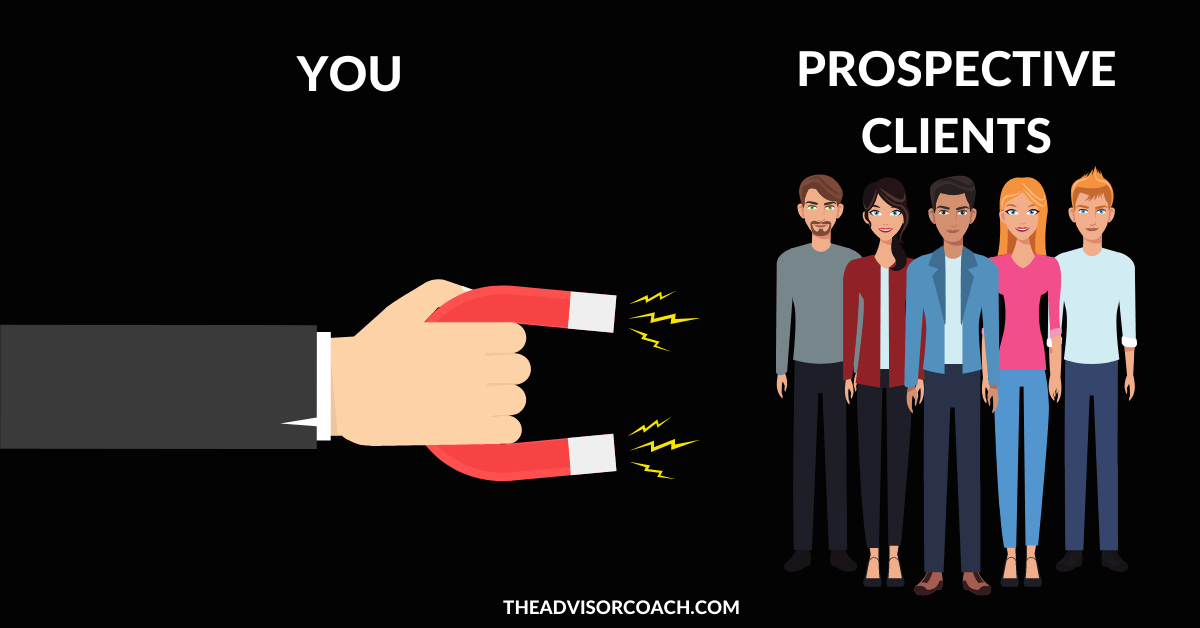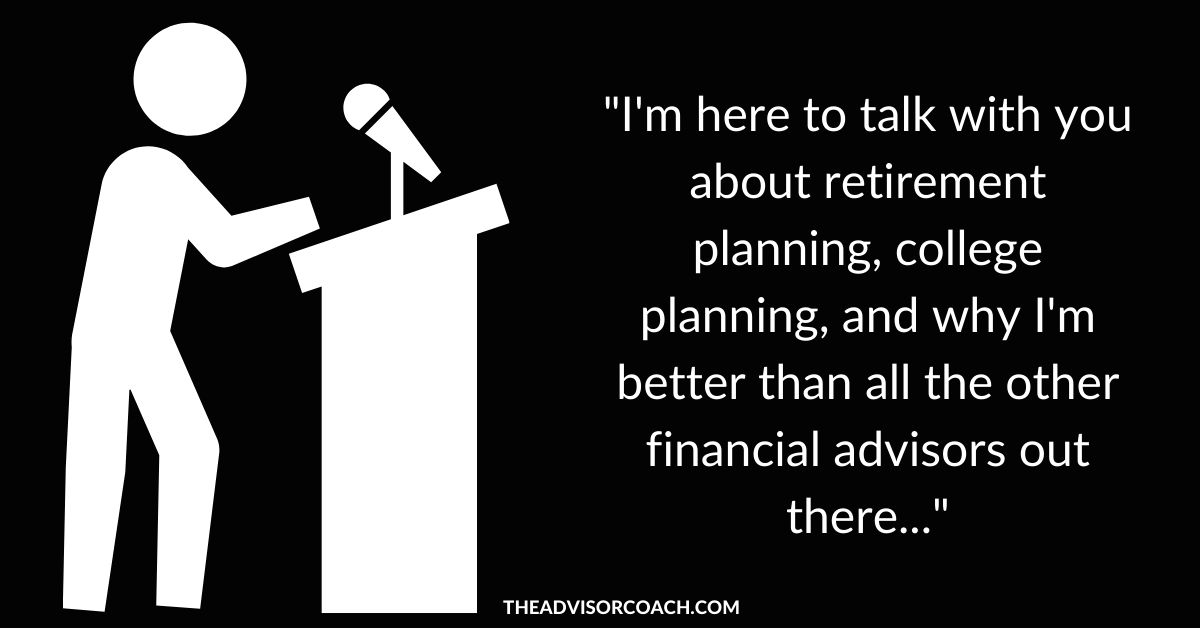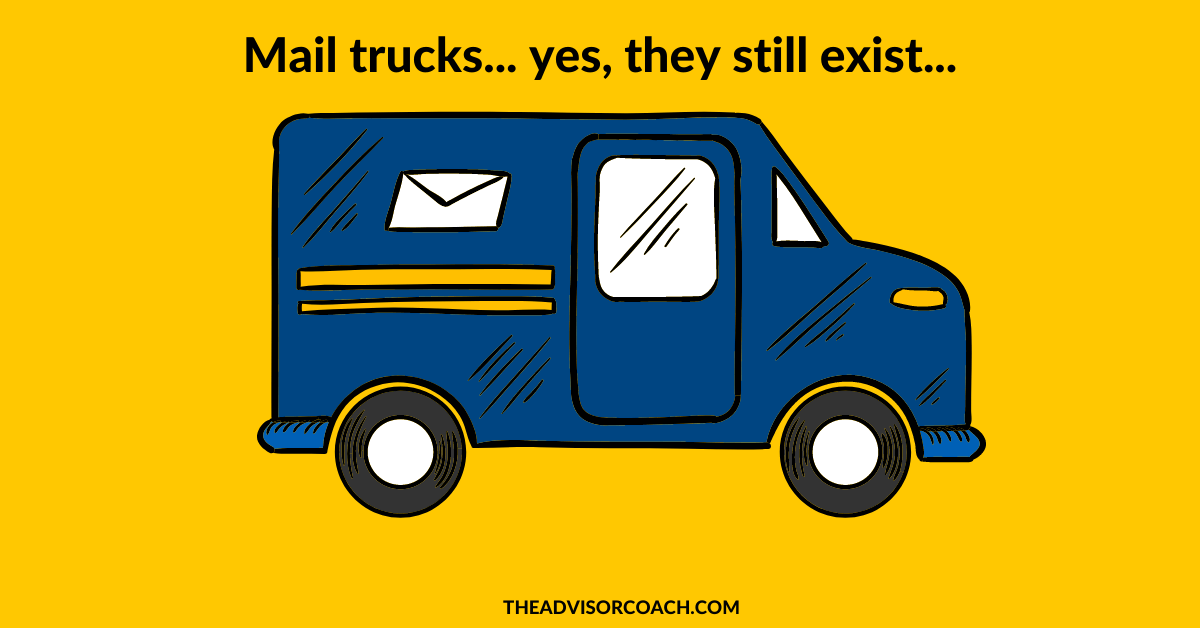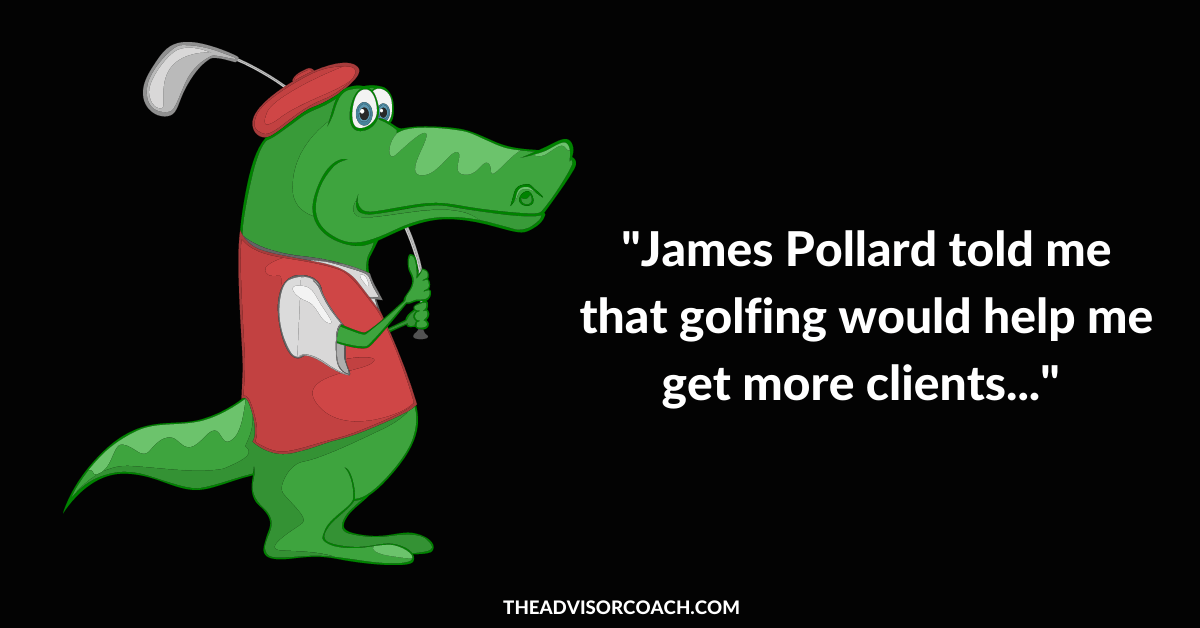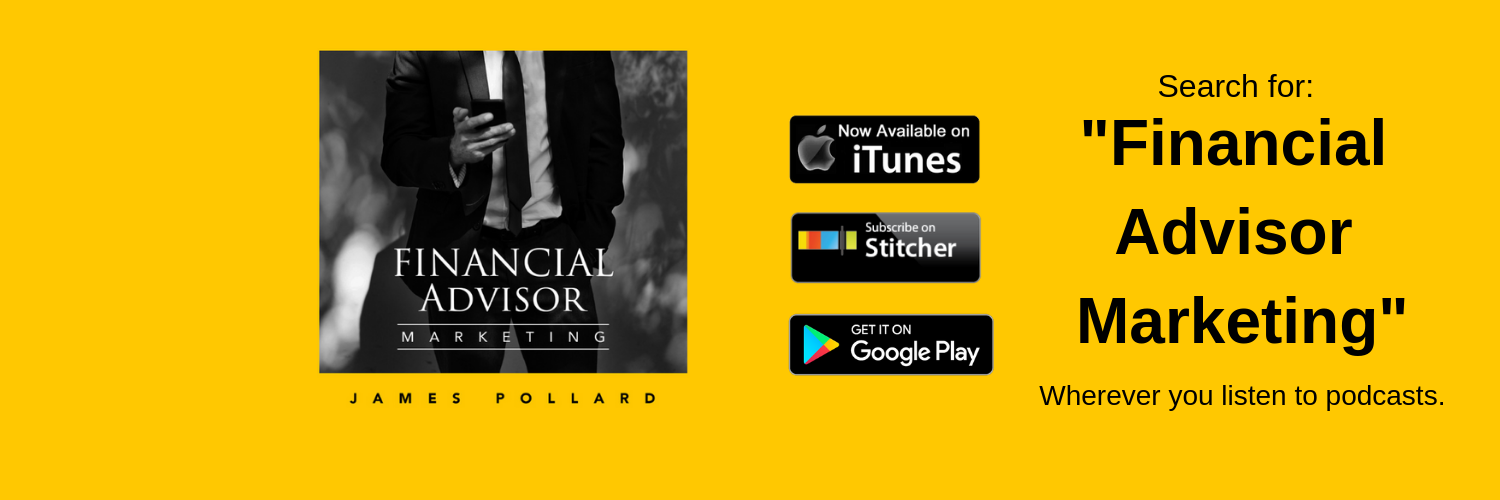27 Financial Advisor Marketing Ideas & Strategies That Work!Marketing ideas – if you’re a financial advisor, you can’t get enough of them.
As a marketing consultant and coach who works specifically with advisors, I enjoy seeing that passion that advisors bring to the business. However, I’ve noticed that most advisors don’t know how to market themselves. I don’t blame them… marketing wasn’t really taught to me either. I had to self-teach a lot of things, and the rest was by trial-and-error. I understand that as a financial advisor, it’s easier to work “in” your business than working “on” your business and marketing. Thanks, Michael Gerber! Because I am the guy who helps financial advisors and financial planners get more clients, it is my personal responsibility to make sure you have the knowledge and skills you need to succeed in the marketplace. I hope that you can take these financial advisor marketing ideas and implement them in your own life. I love sharing different marketing tips and strategies I’ve heard from financial advisors over the years. In this massive 6,000+ word post, I want to share with you some ideas that you can take and implement into your financial advisory practice. Interested in something specific about financial advisor marketing? Jump ahead to: But First, Understand That Strategy Is King 👑Before you act on any of these marketing ideas, understand this: Strategy is everything. In an episode of my Financial Advisor Marketing podcast, I shared why strategy is more critical to your marketing efforts than the tactics themselves.
If that shocks you, think of tactics as tools. Like a hammer is useless to tighten a lug nut, tactics don’t mean anything until you put them into the right context or strategy. That’s why financial advisors who don’t succeed are often those who focus too much on tactics, religiously follow them and apply them to every situation. If you care more about the trendiest email marketing tactic than the big-picture strategy, you’re headed down the wrong path. (Unfortunately, so is your bottom line.) Don’t get me wrong. No tactic is bad or good. For any to be truly effective, they need to be combined with a strategy — one you customize to reach your target market. This is where you can get creative. To create a winning strategy, see your tactics as chess pieces and the strategy as how you move them across the board. You don’t beat your opponent by playing one chess piece and pushing all the others off the board, right? Rather than swap out a tactic to try a new one, incorporate new efforts into your overall strategy, and make it even more powerful. You never want to cut something that works (or keep something that doesn’t), so build on it with new tactics to strengthen your reach. You can always pick and choose tactics later, but it’s a recipe for disaster to focus on them without a strategy. Because before you deploy any tactic, you have to make sure you use it correctly. Once you find a prospecting strategy you enjoy that aligns with your business model, don’t let go of it. To ensure it remains effective, here’s the question to ask yourself about your tactics: Does this activity move the needle forward? If yes, do it. If not, don’t. It’s that simple. 1. Set Goals.
This may not fit into your typical mold of marketing advice, but it’s incredibly important. (That's why I created Goal Setting for Financial Advisors). If you don’t have a target, nothing else matters. I can’t stress this enough. Setting goals makes all the other financial advisor marketing ideas fall into place.
Have you ever wondered why some people seem to work so hard for so little? While others don’t work as hard, yet seem to have everything? These are people who seem like they have the “magic touch”. The difference is goals. Some people (a very small percentage) actually have goals, while others don’t. People who have goals succeed because they know where they’re going. Sounds too simple, but it’s true. However, here's something most people don't think about when it comes to setting goals: you must have a foundation first. I love setting goals. Goals are awesome. It excites me when financial advisors write to me and tell me how they're focused on crossing the million-dollar mark or that they have a goal of changing one hundred lives. However, goals are just wishes if there are no plans and systems backing them. For example, I could set a goal to write a 50,000-word novel... OR I could set up a system that enables me to write 500 words per day. See the difference? One influences action while the other is likely to remain wishful thinking. The system serves as my foundation. Once I have that foundation, I can get into the habit of writing every day... and that habit will automatically push me towards my goal. ALSO READ: How to Become a Successful Financial Advisor 2. Know Your Target Market.
You should be able to describe your perfect client to me so I can visualize him or her with absolute clarity. You need to know demographics (age, gender, locale, profession) as well as psychographics (how do they think?). Don’t lie to yourself and say that you market to everybody. If you do this, you will fail. Remember that the “riches are in the niches”, and if you specialize enough, knowing your ideal client will become that much easier. Take me, for example: I’m not a marketing coach for everyone under the sun. I work exclusively with financial advisors, so my target market is easier to define.
Many financial advisors focus on entrepreneurs, divorcees, retirees, widows and company executives. You could go even further and be THE financial advisor for dentists or THE financial advisor for plumbers. Don’t believe that if you “cast a wide net”, you’ll get more business. In reality, the opposite is true. As you go narrow, you will get more clients. Also, don't fall into the trap of thinking that "women" is a niche market. Or "small business owners". Or "retirees". These aren't specific enough. Getting specific with your niche is the way to "level up" your entire marketing machine. It's like driving a Ferrari while everyone else is putt-putting along in a Volvo. If no one’s told you this yet, let me be the first: You’ll go broke trying to give people what they need, but it’s easier to get rich if you give them what they want. Realistically, most people may need your financial advising services, but that doesn’t mean they want them. The most profitable strategy is to target potential clients who demonstrate their interests and the content they value by interacting with it. For instance, when you share an article about budgeting, income investing, or annuities, the people who comment or DM you to say they plan to implement your advice are potential clients who show you they value financial planning. If they share your content or engage with it consistently, consider that a signal of their possible interest in your services. Whatever your specialty, use social media to engage your audience with content that explains how to solve problems associated with your niche — the more specific you can be, the better. 3. Get Your Own Financial House In Order.I'll never forget when I went shopping for my first car... 🚗
I saved up my money from several summer jobs, as well as from doing chores (washing cars, mowing lawns, shoveling snow, etc.) for friends and family members. My mother accompanied me to the dealership to ask all the questions 16-year-old me wouldn't know to ask. There we were, at the Chevy dealership, looking at some of the Camaros. We were talking with a salesperson when, suddenly, a car alarm starting blaring. We turned around and spotted the culprit car: a shiny new red Honda Civic. The salesperson pulled out his keys, disabled the alarm, and meekly apologized. We thought to ourselves, "Well, that was awkward", thanked the man for his time and promptly left the dealership. Why? Because this person was selling Chevys but drove a Honda. See the disconnect there? Some financial advisors are foolish enough to commit this grave error. Fortunately, it's easily fixed. Because owning what you sell (aka getting your financial house in order) is one of the most important marketing principles you can ever embrace. If you're selling insurance, you BETTER have insurance on yourself... If you provide financial plans, you BETTER have a plan made for yourself... And if you're providing financial advice, you better -for the love of all that is good and holy - have your own finances in check. Because nobody can ever be a success who sells something of which he/she is not proud. Sure, I know there are plenty of people who make plenty of money selling crap. So what? Money is only one (and truly not the most important) of all the ingredients that make someone a success. And making money (even millions) while losing your self-respect leads to dry rot of the psyche and a constant aura of despair that dulls the fabric of your life. If you’re doing something you don’t believe in, stop doing it. Or find something you DO believe in. You’ll thank me later. And as far as marketing is concerned, you might feel reluctant to put yourself out there – to make those calls, to send those flyers, etc. At some deep level, you might be afraid of rejection or want to remain humble and modest. However, a tremendous shift occurs when you are doing a disservice if you don’t market! All of a sudden it becomes your duty to take massive action and get your face in front of as many prospects as possible. If you don’t market, not only are you missing out on the extra money, your prospects are missing out on the best possible service they could get. Your own beliefs also get in the way of how much money you make. For example, some people are squeamish about asking for (and accepting) money from people. One of the best business books I've ever read is an obscure book called "How To Sell At Prices Higher Than Your Competitors" by Lawrence L. Steinmetz. In that book, Mr. Steinmetz said he would fire any sales reps who were price shoppers in their own lives. Why? Because those sales reps would project their own price-shopping beliefs onto their prospects. The reps would mistakenly believe that their prospects bought on price. In reality, price is almost always more important in the mind of the seller than the buyer. The person trying to sell on price ends up doing all sorts of mental jumping jacks to justify the "cost". That's just one example of how negative beliefs can sabotage you. If you can change your beliefs (which is effectively done by eating your own cooking), your marketing will follow. ALSO READ: 9 Elevator Speech Tips for Financial Advisors 4. Understand Your Client's Motivations.
Almost every financial firm says that they provide customized, high-quality service. The truth is that most firms don’t have the slightest idea of how to customize their service for their clients. Yes, you might put a client in more bonds if he wants to be conservative, but can you really connect with them on a deeper level?
Doing this requires that you understand the motivations of high net worth individuals. By understanding where they’re coming from and their personal investment goals, you’ll establish a profitable, long-term relationship. Remember, it’s not the money. It’s about the reasons behind the money. Most people’s primary goal with investing is to take care of their family. When you’re talking to clients, don’t talk about the investment product itself. Instead, talk about how it can meet the family’s needs of education, retirement, weddings, travel, and so on. They’ll give you clues too; they’ll talk about their kids and college planning. Once you figure out a motivation like this, you’ve got the rest cut out for you. Just involve key family members and remember family occasions. Show them how important your own family is to you, emphasize experience in working with families… you get the idea. Other clients, I’m willing to wager about 1/5th of them, don’t even want to talk about investing or finance at all. They’re not knowledgeable about the field and they don’t want to even approach the subject. Imagine being the idiot using complicated jargon with these folks! They’ll leave you faster than you can say “derivatives”. These people will focus on building rapport, and they’ll talk about anything they possibly can besides investing. All you need to do with these clients is simplifying concepts and provide support. Figure out what your client’s motivation is by asking questions such as:
Once you figure out their true motivation, you cater your approach to them. If their family is their biggest concern, you explain how you’ll focus on their family and really take care of them. If they only care about accumulating more money, you tell them how you enjoy working with clients like them and how you’ll do your best to make the most money possible. If they don’t want to talk about investments, tell them that you get the feeling they aren’t comfortable with investing, but you are, so you’ll do whatever it takes to meet their goals and eliminate worry. One of the ways I help financial advisors get more clients and make more money is by getting them clear on WHO their ideal client really is. The best way to do this is through exhaustive market research. Perhaps the best market researchers I've ever seen is children's horror author R.L. Stine. You see, Mr. Stine is one of the most prolific authors to ever walk the planet and he's had a tremendous influence on American culture. He's sold more than 350 MILLION books. Pretty insane. During an interview, he mentioned that one of the things he loved to do was visit schools. Because he could meet the children who were reading his books. He could interact with them, ask them questions, get feedback, and more. In other words, Stine was getting his information straight from his prospects' mouths. If the children didn't like something, they would let him know and he would adjust accordingly. That type of research is why his books flew off the shelves so rapidly. Kids couldn't get enough of R.L. Stine because he knew them. The same idea applies to financial advisors. Because the most successful financial advisors are the ones who are most in sync with their markets. It's that simple. The better you know your audience, the easier it will be to optimize your marketing. 5. Send Out Birthday Cards. And Holiday Cards... Like "National Pizza Day"...When you’re putting their documents together, you see clients’ birthdays anyway. Make a note of their special day in your client relationship management software and send out birthday cards.
If you really want to take it to the next level, you can send out cards for EVERY holiday. Joe Girard, regarded as the world’s best car salesman, sent out nearly 13,000 greetings cards per month to his customers. Yes, that’s per month. This guy celebrated everything from Christmas to Groundhog Day. Clients viewed Joe not just as a salesman, but as a member of their family. Imagine the type of influence he had! When you send out these cards, they aren’t just paper and ink. They are a symbol that you’re someone who cares enough to recognize and honor your relationship with them. It evokes a sense of loyalty – a loyalty that pays dividends several times over. 6. Send Thank-You Letters.
It saddens me that not many people send these out anymore. Sending thank-you notes is one of the best financial advisor marketing ideas that has been proven to work. These are so simple, yet so powerful. When was the last time a service professional sent you a thank-you letter? Your clients will appreciate this more than you’ll ever know. It’s a nice touch. You can keep it short and sweet. Say something like, “Thank you for choosing me and ABC Firm to handle your financial affairs. I appreciate your choice and will do my best to serve you.”
Make it sincere and handwritten. Even a post-it note on top of their paperwork will do it. It takes maybe twenty seconds to write one of these notes, but when your competitors knock at their door, they’ll remember this and stick with you. Handwritten notes also go a long way in getting your clients to give you referrals. This is one of the best low-cost, high-reward strategies when it comes to marketing for financial planners. I believe every financial advisor and financial planner should make this part of their overall marketing strategy. 7. Get Your Clients to Complain.
Change your thinking about complaints, because a customer complaint is like a diamond in the rough. A relationship that’s had problems handled well is a stronger and more profitable relationship that has never had a problem.
A study done by The Technical Assistance Research Programs Institute in Washington D.C. revealed that for services, 55-63% of unhappy clients won’t complain. These are people that can help you improve, but they’re not saying anything! Another study, conducted by The Strategic Planning Institute, revealed that the average business never hears from 96% of unhappy clients and 70% of clients will do business again if a complaint is properly resolved. Is your 70% walking away? You need to get your clients to complain! If you don’t figure out their complaints, you can’t fix them. Plus, if one client is having a problem, it’s likely that others are having the same problem. If your customers aren’t complaining, they’ll quietly sneak over to your competitor and tell all their friends about their bad experience with you. This tip isn’t so much about getting referrals as avoiding bad ones. Once you hear a complaint, apologize, don’t argue and get to work fixing it. Resolve the situation quickly and thank the client for bringing their concern to you. They will know that you value their input, making it likely they’ll immediately tell you the next time something goes wrong. 8. Get Featured In Trade Magazines.
It’s especially important that you specialize, so you can take advantage of these trade publications. If you’re known as “the dentist’s financial advisor”, you can get some space in dental trade publications. You know that dentists are reading the thing – why not plaster your face in front of them?
You don’t have to do paid advertising either. These trade publications are constantly looking for fresh content. Send an email to the editor or call them cold and say you would like to contribute an article about how dentists can better manage their finances. Be sure to make it specific to dentists! Otherwise, there’s a 99% chance that you will get turned down. Pitch the editors several ideas, have them choose one that they think will provide the most value and then get to work. The reason I tell you to pitch several ideas is not just for convenience. You need to pitch more than one idea so that it increases the likelihood of the editors choosing one. Once they’ve chosen an article idea, they’ve made a commitment, which is good! It will be much harder for them to reject you past this point. If you call them and pitch them one topic only, they could just straight up turn you down. When you present them multiple options, you’re appearing to give them control of the situation. 9. Speak At Meetings.
Local clubs and organizations are constantly looking for speakers to come to visit their groups. I’m talking about educational institutions, churches, charities, outplacement services, special interest groups, hospital auxiliaries, the whole shebang!
I’ve seen several advisors charge a fee to attend the speech/seminar and then donate it to the group they are speaking for. More people will visit because they’ll view it not only as an educational opportunity but a charitable one. If you are cold-calling CFOs, it might take you weeks to get in contact with fifty of them. If you book an event or workshop specifically for CFOs, you’ll have all fifty of them focused on you. Talk about high efficiency and enormous payoff! When you speak at these meetings, a lot of them will tell you over and over “NO SOLICITING”! And that’s fine because you won’t be there to solicit anyway. You’ll be there as an expert looking to add value to the group. Besides, you won’t need to solicit anyway. By speaking at the group, you’ll receive an implied endorsement. When the leaders of the group book you to speak, they’re essentially saying that they view you as a trustworthy expert. Not many marketing ideas will allow financial advisors to get into a room of pre-qualified prospects quite like this one. ALSO READ: 9 Actionable Seminar Marketing Tips For Financial Advisors 10. Use An Evaluation Form When You Speak.
Check with whoever booked you to speak and ask if you can use an evaluation form. If they seem hesitant, explain that you want to become the best speaker you can possibly be and that you would greatly appreciate it. After all, how can you fix what you don’t know is broken?
Because you can’t (and shouldn’t) solicit during your presentation, the evaluation form helps you subtly sell the audience members on meeting with you. Briefly explain how you’re passionate about helping your clients solve their problems and that you’re always looking to improve, so you’d appreciate their feedback. On the form, you get their name, number, address, and the best time to call. All very important information to keep in your CRM! You ask them what they liked the most, what they didn’t like, and what they wish you focused more on. Here’s the kicker: at the very end of the evaluation form, say: “By completing this workshop/seminar, you have earned a complimentary consultation with me” and then have options for them to select. The options might say, “I want to get started immediately. Call me as soon as possible”, “I’d like to find out more first, please call when it’s convenient”, and “No thanks”. Let’s say you speak to fifty people – thirty might say no thanks, fifteen might want to learn more, and five would want an immediate appointment. Sure beats cold calling, huh? 11. Know How Much Money You Make Per Direct Outreach.
You work to make money, right? Yeah, you might love what you do and all that cool stuff, but you need to pay the bills. In financial advising, you have the incredible ability to control your income. Please do not take this for granted! Here’s what I mean...
Let’s say you call a hundred prospects and get ten appointments. Out of those ten appointments, three people become clients. You make five hundred dollars from each client, so you make $1,500 for every hundred calls you make. It never ceases to amaze me how many financial advisors don’t think of this stuff! This means that every single time you pick up the phone, you’re making $15! Figure out how many calls it takes you to make an appointment. Then figure out how many appointments it takes to get one client. You should know approximately how much you make per client. From there, you can figure out exactly how much you make per phone call. Do you want to make an extra hundred bucks? Pick up the phone. You’re behind on your bills? Pick up the phone. This is an incredibly motivating thought to hold in your mind. Whenever you feel any call reluctance or if people give you a hard time over the phone, you can think, “Thanks for your $15!” and hang up. You need to keep track of these three things:
When you're implementing these financial advisor marketing ideas, knowing your numbers can keep you from getting discouraged along the way. Knowing your numbers also makes setting goals (the most important tip) a breeze. Figure out for yourself what numbers you want to make. Find out how many appointments you have to set every week in order to make the total number of sales every month. Once you have the numbers, the rest becomes basic math. I’ve always liked the “thanks for your $15” style, but there’s another interesting way to think about making phone calls, one that made me more comfortable back when I had call reluctance. I found that it was a lot easier for me to picture my prospect list like a big deck of cards. I would imagine that every single King I’d pick out of the deck would net me $100, while every other card would net me $0. I knew that if I kept plugging away, I would eventually get the Kings. This kept me from getting discouraged when I kept drawing twos and threes. 12. Call "One More".
At the end of the day, right after you’ve packed up your papers and put on your jacket, call one more prospect. When you can make this a habit, you’ll be a sales superstar. Assuming you do this every day, you’ll get way more appointments over the course of a year.
The difference between success and failure is often razor-thin. In a horse race, the second-place horse might be only a split second behind first place but it will still miss out on the huge first-place purse. You need to understand that this “one more” phone call will mean the difference in your career. ALSO READ: 5 Things You Can Do Instead of Cold Calling 13 Build Your Prospect List At Night.
Don’t waste your time building your list during the day. So many advisors will get to the office and get straight to work on building their list. The truth is, the list should’ve already been done the night before, or possibly the week before!
During the day, you should be doing the two M’s: Marketing and Meeting! You need to be in that office, either prospecting or working with a client. Don’t ever forget that. If it is a weekday between 8 a.m. and 6 p.m., you need to get your butt in gear and hit the double M. Building a list is what’s called a “zombie task”, meaning it’s not a cognitively demanding task. You can sit in front of a computer at 9 p.m. and put your list together. Other zombie tasks include organizing, cleaning, sending email responses and entering info into your CRM. Zombie tasks serve as major distractions for those with call reluctance. They’ll tell themselves that they’ll call as soon as they enter all the information into Excel or their CRM, but they never make the calls. 14. Always Leave a Voicemail.
This is a mistake that I’ve personally made. When I first started out in business, I would never leave a voicemail message. I don’t even remember why I didn’t leave one! I guess I figured that someone would see the missed call and give me a call back. Yeah, right!
If you saw an unknown number on your phone, would you call it back without a voicemail? Nope! You figure if it’s important enough, the person will leave a message. I was making a huge mistake! Here are a few reasons why you should always leave a voicemail:
The final reason is a little something called... uh... math! Because, according to InsideSales.com, the average voicemail response rate is 4.8%. Statistically speaking, this means half of all people will be worse and half will be better. If your callback percentage is worse than this, I'm sorry, but you're below-average. That's how math works. Of course, your goal is to be better than average, and experience tells me that even a mediocre voicemail script can put your leagues above everyone else. But let's assume that you're drop-dead average and only get one callback for every twenty voicemails you leave. Assuming each voicemail you leave takes you thirty seconds, that means it only takes you an additional ten minutes of effort to generate a callback. 🤯 I'll take those numbers all day long. Still, far too many people run their businesses based on emotion. Some financial advisors swear up and down that leaving a voicemail is a waste of time because they haven't done the math. They're running their businesses based on how they FEEL, not based on what gets RESULTS. ALSO READ: 7 Ways Prospecting Is Like Dating 15. Understand The Difference Between Response and Results.
Know the difference between
response and results! The ONLY reason you should be marketing is to get
results, aka conversions. Responses feel good because it tells you that
people are seeing your marketing efforts, but it’s all an illusion.
Some financial advisor marketing ideas can produce a lot of responses, but little results. Responses might feel like results, but your bank account can tell the difference. Make sure you can too. 16. Look For Movers And Shakers.Look over your local newspapers and publications every so often to spot the movers and shakers in your area. Did anyone get a promotion at a major company? Is anyone receiving recognition for their contribution to academia or business? Reach out to these people and say congratulations. Use their accomplishments as an excuse to call.
Don’t try to sell anything; just say you’re a financial advisor and you work with clients like them, so naturally you found them in the paper. You should also consider sending them a few copies of the article, complete with a couple of your business cards. They probably have their own copy, but it’s a nice gesture and it’s way better than going straight for your pitch. One of the best ways to market to the affluent is to use their accomplishments and awards as leverage. These people tend to be accomplishment driven. For example, John Smith might be a successful dentist with tons of offices around your state. He’s got more money than he’ll ever need, so what makes him happy? Mr. Smith likely gets happiness from recognition among his peers. So when you see his name in some dentist publication or in the news, be sure to stroke his ego a bit and let him know. It goes a long way. 17. Make Your Website Look Professional.Please, please, please don’t have a crappy website. For most people, it is the first impression they get of your business. Financial professionals are notorious for having the worst websites in all of humanity.
Now, I’m NOT saying my website is the most beautiful website in town, but after extensive A/B testing, I am finding what works. I’m not saying that you need to hire an expensive web designer, but I am saying you should strongly consider having one look at your website and giving you their honest opinion. Just find one of the best, send him/her a message offering to pay them a few hundred bucks to get them to tell you what to change and how they would change it. I am by no means a web designer, but I know what works, so here are a few ideas.
18. Don't Worry About Web Traffic - Focus On Conversions Instead.Web traffic does matter, but not nearly as much as people think it does. You should allot your energy towards your site’s user experience. Traffic is worthless if it’s not converted into paying customers. I’d much rather have high-converting sites with 100 visits per day than a no-converting site with 10,000 visits per day.
To improve user experience, make your site easy to navigate with easy to follow information. Don’t use any financial jargon. Don’t have any broken links and have a welcoming design. Be sure to have your contact information on every single page – don’t EVER make your clients search for your contact info. If it takes longer than three seconds to find your phone number or email, they’ll leave forever. Also, take extra care to maximize your “above-the-fold” use. This is the area of your website (the top of the page, they’ll see it without having to scroll down) that people see as soon as the page loads. Here's an example of how a small tweak can dramatically improve your website... Once upon a time, I reviewed a financial advisor’s website and found the most garbled, wordy “value proposition” I’ve ever seen on his homepage. I don’t remember the exact wording but it went something like this: “We are a small, boutique firm with the ability to make research-backed decisions to provide our clients with superior, personalized service that maintains our advantage over large, impersonal, one-size-fits-all firms.” I immediately pointed this out and told the financial advisor to change it. He worked with medical professionals and ended up changing it to this: “We help medical professionals make smarter financial decisions.” MUCH better. I reckon that one change alone doubled or tripled his conversion rate. You see, it’s not that hard to make your website more effective. You just have to know where to look. Sometimes that requires having a fresh set of eyes to look at everything. And I’ve discovered that there are lots of financial advisors who want to improve their websites but don’t know where to start. Even hiring a fancy web designer is fraught with a major flaw… They make websites look pretty… and here’s the problem… Pretty doesn’t convert. Web designers rarely have the marketing expertise necessary to know what works and what doesn’t. My personal philosophy is that your website should be making you money. I could care less about looks or design, as long as the conversions are there. I'm running a business, not a fashion show. In my opinion, the purpose of a website is to maximize your chances of turning a web visitor into a lead and then into a client. 19. Get Familiar With Employers In Your Area.Most employers will have 401(k)s and other benefit plans. If you network with employers and human resources in your territory, you can gain the name of employees nearing retirement age. From there, you can get referrals to their coworkers.
At least offer to come in and speak to their employees about investing and retirement. Get a list together of large (and small too, I suppose) companies in your area and get in touch with human resources. LinkedIn is great for this because you can narrow your search by keyword and geographic area. Call or email them cold to introduce yourself. Explain that you want to come in and talk to their employees, completely free. They’ll be wary about you soliciting, so if you assure them that you won’t solicit, you can come in and talk. Just have a presentation ready in case they ask to see it. When you go to speak with the employees, put your name, email address and phone number on every piece of material they see. Papers, PowerPoint slides, everything. You won’t be soliciting, but you’ll keep your contact information visible at all times. Ask the company if you can do an exit survey. If they let you do one, you can get the employee’s information and contact them at a later date. The reason this particular tip is so effective is because all the steps are ready-made. You don’t need to do much work to find the human resources. You shouldn’t encounter much resistance, because the employers will view it as a benefit they provide to their employees. The employees who attend obviously care about their finances/investments, so they’re already qualified. All you need to do is go in there and knock it out of the park so you can go home with a few warm leads. If you're a financial advisor who lives in an area with large employers, this can be one of the best marketing ideas for you. 20. Use A Three Letter Referral Campaign.This is a classic financial advisor marketing idea. I think that direct mail is so underrated. Even the advisors that don’t send out anything could benefit from sending out three referral letters, spaced two or three months apart. I am just saying three letters as an example, but the idea is to position yourself as the “go-to” person for financial services help.
Your first letter should be sent right after your client review meeting, ended with a subtle request for referrals. Your second letter should let your clients know about a client appreciation event you have coming up. Let them know that you want them to bring a guest. The third letter is more direct, where you ask if they know anyone who fits your target market. Again, this doesn’t have to be on the third letter. You can mix more educational pieces in there. You just want to make sure that you remain top-of-mind. 21. Improve Your Hold Music.What does your hold music sound like? My personal attorney does this beautifully. His hold music is an advertisement for his services and his podcast. I’ve noticed that there are a few levels to hold music – where does yours stand?
22. Have a Movie Night.Partner with a local movie theater (or rent it out) and throw a client appreciation event. It can be a private, family-friendly movie night with popcorn and the works. This is incredibly powerful with your family-oriented clients because they can bring children and grandchildren. It’s just something fun you can do to strengthen your client relationships. It costs more to rent out a theater on a Friday night versus a Monday morning, but you shouldn’t pay more than about $600. It’s well worth the cost.
23. Sponsor Youth Sports.Through a sponsorship, you will get your name in front of the youth sports market of parents, coaches, program organizers, players, and fans. Plus, it isn’t likely to get tuned out. People in this market, especially the parents, like to check out the companies are supporting local sports.
I really like this marketing tactic and I think it goes beyond dollars and cents. When you sponsor a youth sports team, you are helping to keep participation fees low, which means more families can afford to sign up their kids. When you sponsor a team, you are allowing more children to receive the many benefits of sports. 24. Donate To Charities.Similar to sponsoring a youth sports team, donating to charity allows you to do some good in the world. The kicker is that you should send out a press release when you donate. Let the whole world know that you’re so nice. Or you could send out a card or letter letting your prospects/clients know that you’ve made a donation on their behalf to a particular charity.
Another way to do this is to partner with a charity. If you host a holiday party, ask your clients to bring a toy to the party that will be donated to a charitable organization. 25. Set Up A Golf Clinic.A lot of advisors tout the importance of meeting prospects on the golf course, but they do it casually. I’ve seen financial services companies sponsor golf tournaments, putting contests, longest-drive contests, etc. but golf clinics seem to be the most effective.
The idea is to appeal to your prospects’ passion for golf and do it in such a way that adds educational value. You meet with golf pros at your local club and set up the clinics. The people at the club love these clinics because it creates revenue for them. It gives them an opportunity to showcase their expertise and possibly book extra lessons from the people you bring, who, if they aren’t already, may become members of the club. After the clinic, you can conduct a brief presentation and serve refreshments. It’s truly a win-win event because your prospects/clients get a golf lesson (and investment information) and the golf pros get exposure to new customers. You can also do these clinics with other sports, like tennis. 26. Send Postcards (And Other Direct Mail).Whenever you travel (such as on vacation or to conferences), pick up postcards to send your clients. One advisor I know of boxes up the postcards and takes them with him, just because he wants to get the postmark from the place he visits.
When you send a postcard to your clients, you further increase your visibility and credibility with them. After all, it’s not up to your clients to remember you. It’s your job to consistently remind them that you exist and reinforce why they have a relationship with you. A relatively large firm reached out to me once to revamp their marketing. They were sending a TON of direct mail, so that's where I started. Before I helped them, this is how they were sending out their mailers:
Their conversion rate for this particular mailing was .02%. That means that for every 1,000 mailers they sent out, they set two appointments. Conversion rates in and of themselves don’t really matter much, though, as long as you’re making money. But they were spending about $425 to set one appointment and weren’t making that much money from their efforts. Where I come from, we have a saying. It’s “Stop that right now! You’re killing my wallet!” Now, there’s a BUNCH of stuff that I’m going to change going forward (such as the copy, the greeting, the headline, etc.) but here’s what I changed:
What was the new conversion rate? Very close to 2%. With a cold list. Aka this was literally the first time we had any communication with them. So these changes I just gave you allowed this particular group to 10X their conversion rate from direct mail. When we crunched the numbers, we figured out that it “cost” them $47 to “buy” an appointment. Assuming you made more than $47 per appointment, if I gave you an appointment for every $47 you gave me, how many appointments would you buy? Answer: as many as you could! That’s the power of direct mail… and all marketing in general. All we’re trying to do is “buy” a client for less than we make. It’s really that simple. It’s the same no matter what type of marketing you’re doing - cold calling, direct mail, seminars, social media, content marketing, email marketing, or even door knocking. 27. Get On The Welcome Wagon.Welcome Wagon is the world’s largest welcoming service. It’s a business that contacts new homeowners after relocation, providing them with coupons and advertisements from local businesses.
One of your common denominators for prospects is change. How can you locate people who are in the midst of change? All you have to do is pinpoint new people moving into town. Welcome Wagon literally does this for you. Contract with Welcome Wagon to be included in the mix when they visit new families. A good item to give these families, in addition to some literature and your business card, is a refrigerator magnet. Most people eat every day (or if you’re like me, several times per day) so they probably go to their refrigerator several times per day. Once the Welcome Wagon visits a new family, you can get their name and number. Then you just pick up the phone and introduce yourself to welcome them to the community. Well, there you have it - 27 tips that you can use to create your own financial advisor marketing program. If you have any other ideas for marketing a financial planning practice, please feel free to send them to me! ALSO READ: 7 Fatal Prospecting Mistakes You Can't Afford to Make Hungry For Even More Financial Advisor Marketing Content?You're in luck, because I host a podcast that's literally called...
Financial Advisor Marketing! (You can tell I'm not very creative with titles...) Anyway, I've got more than 100 episodes available for you to download. All you have to do is search "Financial Advisor Marketing" wherever you listen to podcasts or use the podcast player on this page. I look forward to having you tune in! |
